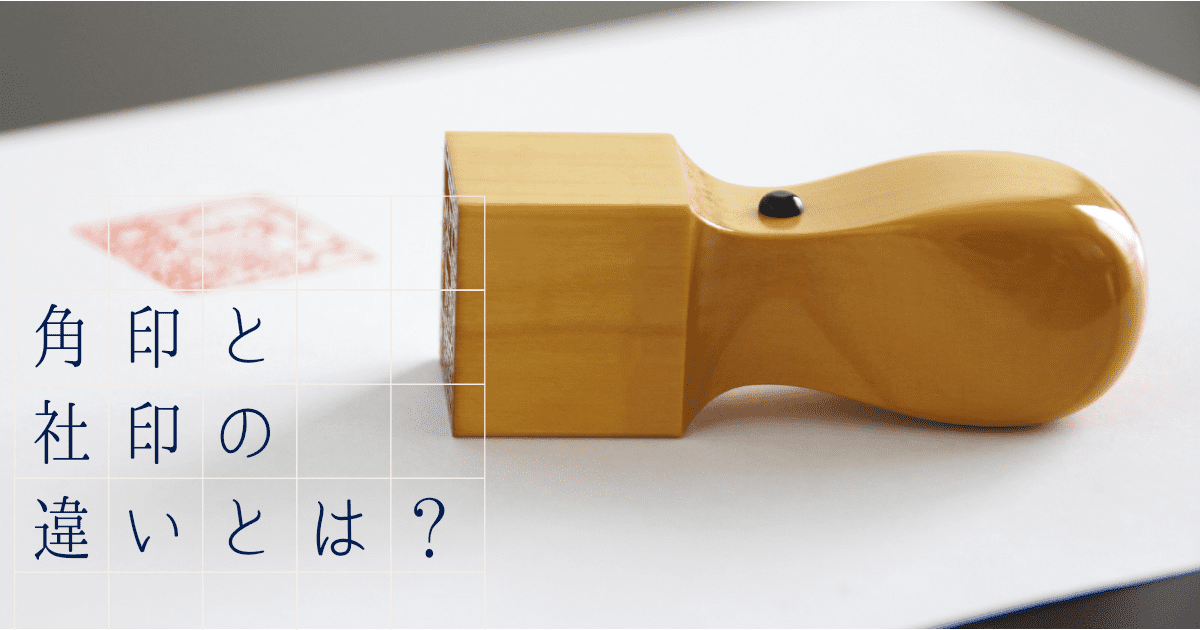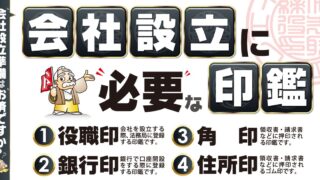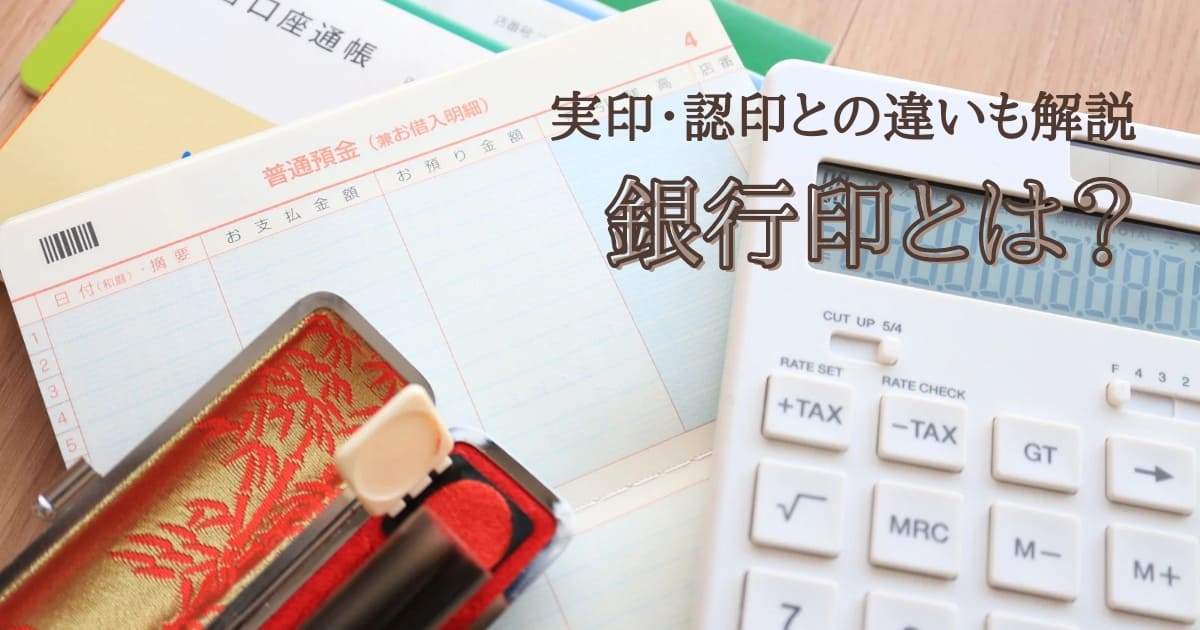Published October 21, 2022
Added on July 28, 2023
Although both are HANKO used by companies, there are differences in the definition and purpose of each HANKO.
In this article, we will provide an easy-to-understand explanation of the types and differences of HANKO used in corporate business activities, such as square seals and company seals. The article also introduces how to make a company seal and the advantages and disadvantages of various square seals, so please take a look.
- name of HANKO
- Difference between square and round stamps
- What is Kakuin?
- Scenes in which square seals are used
- Points to remember when creating a square seal
- How to make a square seal (company seal)
- Seal of sole proprietorship or freelancer
- Types of square seals and their advantages and disadvantages
- How to use square stamps, company stamps, and round stamps
- summary
name of HANKO
First, let's sort out the names of the HANKO used by companies. We will introduce four types of HANKO: square seal, company seal, company seal, and round seal.
Square seal: company seal
A square seal is a seal in which the seal impression (the imprint of the HANKO) that is created when the HANKO is affixed is surrounded by a square frame.
It refers to all square HANKO, but it is also called a ``company seal'' because square seals are widely used, mainly those with a company name engraved on them.
HANKO used by companies often come in a set of three: a registered seal, a bank seal, and a square seal, and one of the three seals is a square seal (company seal).
It can be said that it is the most frequently used HANKO among the HANKO used in companies, as it is often used for daily tasks such as stamping estimates and receipts.
A square seal has the company name engraved on it and is often stamped on documents related to business, but it is not a HANKO that is registered with a government office or bank like a registered seal or a bank seal. Therefore, in recent years, an increasing number of companies are using electronic HANKO.
Company seal: A square seal with the company name engraved on it.
Next, let's talk about the company seal.
A company seal is a square HANKO with the company name engraved on it. However, since the main use of square stamps is as a company seal, the general understanding is that "company seal = square stamp."
Company seals are affixed to documents that require confirmation during work, such as estimates and receipts. Having a seal affixed is also an expression of intent that the company has confirmed the contents of the document.
Personally speaking, I think it's easier to imagine a recognition similar to a seal.
However, the reason why documents are stamped with a company seal is that it gives an impression of external credibility. For example, if you compare a document with a company seal on an estimate and a document without a company seal, you will get the impression that the document with the seal is a more formal document. Business operations are partly based on trust with others, so stamping your business with a company seal can be a way to gain even a little trust in your company.
Company stamp = company HANKO
You may have also heard the word "shaban" which means a company HANKO.
Company stamps refer to all HANKO used in corporate activities. Company stamps include the square seal (company seal) introduced above, as well as other HANKO such as round seals (representative seals), round seals (bank seals), and rubber stamps.
A company stamp has a wide range of meanings, and many people think of it as a ``company HANKO,'' but please note that the type of HANKO that a company name refers to may differ depending on the company.
In some companies, the company stamp indicates the address stamp, and in other companies, the company stamp indicates the square stamp. When your boss or other person instructs you to affix a company seal, it is a good idea to check what type of HANKO it means.
Circle seal = corporate seal/bank seal
Maruin refers to a HANKO in which the impression created when the HANKO is stamped is surrounded by a round frame.
In a set of three HANKO used by a company, one is usually a square seal and the other two are round seals. The two round seals each have different uses and meanings; one is the seal of the company's most important representative, and the other is the bank seal used for financial procedures.
By registering the HANKO created in advance at the Legal Affairs Bureau, it becomes possible to publicly prove that the decision was made by the representative of the company as a company seal. Therefore, when concluding an important contract, you may be required to submit a `` HANKO Impression Certificate'', which can be obtained from the Legal Affairs Bureau where the HANKO was registered, along with the seal on the contract. The company seal is the most important HANKO, and you should be careful to manage it so it doesn't get lost or stolen.
Difference between square and round stamps
The HANKO are one square seal and two round seals. Let's check the difference between the two.
square seal
Square seals are often used in daily work and HANKO as a personal seal. It is not necessary to create a HANKO as it is not required when establishing a company.
Having a square stamp properly stamped on estimates and invoices will give you a sense of trust from business partners and customers, and by using it differently from the circle stamp used on important contracts, you can reduce the frequency of use of the circle stamp. This allows you to avoid risks such as depletion and counterfeiting.
Square stamps are used to stamp general contracts other than important documents that use round stamps. There should be no problem with stamping a square seal on contracts for newspapers, water servers, coffee machines, etc.
Circle seal (representative seal/office seal)
On the other hand , a round seal is a HANKO used for important company contracts. It is divided into a company's most important official seal and a bank seal used for filing with financial institutions.
In particular, the representative seal is a personal seal that can legally certify the representative's intentions and decisions by registering it with the Legal Affairs Bureau. Personal seals are also the HANKO that are most at risk of being misused through leaks or forgery. To properly manage them, care must be taken to avoid using them for anything other than important contracts for the company, to reduce their frequency of use as much as possible, and to avoid using them in conjunction with other HANKO such as bank seals.
The representative seal can be used to stamp contracts related to the company's core business, such as stock issuance, real estate transactions, and machinery leasing agreements, as well as when submitting notifications to government agencies.
In addition, in order to keep company contracts and financial transactions separate, we recommend that you prepare a separate round seal (bank seal) that is separate from the representative HANKO to be registered with banks and other financial institutions.
How to stamp a square seal
As for how to stamp a square seal, it is common to stamp it so that it overlaps the company name and company address. Specifically, the seal should be placed on the right side where the company information is written. By aligning the last letter of the company information with the center of the seal impression, and aligning the top and bottom of the company information with the top and bottom of the seal, you will be able to get a clean stamp.
However, there are no official rules regarding the location of the square seal. Be sure to match your company's customs and the sealing method of your business partners.
How to stamp a circle stamp
When stamping a circle stamp, make sure that it does not overlap with the company name or company address. The reason is that in the case of a round seal, it is necessary to check the seal impression on the HANKO certificate.
In the case of a square seal, there is no need to verify it, and it is necessary to prevent it from being forged or misused, so the stamp is placed over the letters. Also, depending on the document, there may be cases where both a circle stamp and a square stamp are affixed. In that case, the circle stamp should be stamped to the right of the text, and the square stamp should be stamped so that the center of the stamp is aligned with the center of the company information. Even if you end up stamping both, the circle stamp will still be stamped in a location where verification can be made, and the square stamp will be stamped in a location where it cannot be forged.
What is Kakuin?
Kakuin is generally a square-shaped HANKO, and the impression left when stamped on a document with ink is also square. It is rarely used for personal use, and is known for having a set of three seals for company use: a registered HANKO, a bank seal, and a square seal.
Kakuin is sometimes called ``shaban'' or ``shaban,'' but care must be taken not to confuse it with shaban. A company seal is a general term for all types of HANKO used in companies, and a square seal (company seal) is one of them.
Scenes in which square seals are used
The company's representative seal is the one that was HANKO at the Legal Affairs Bureau when the company was established. This is a company's registered seal and is also called a "maru-in".
The square seal is the company's official seal and does not need to be registered.
The representative seal is used in important situations such as real estate transactions.
On the other hand, square seals are used on internal notices, estimates, delivery notes, invoices, receipts, etc. given to business partners. Square seals are used by employees involved in the relevant work.
Points to remember when creating a square seal
There are no legal regulations regarding square seals, but if your company has regulations, you will need to make them in accordance with those regulations.
square mark size
A square mark is generally a square with a side length of about 21 mm to 24 mm. However, as long as the side length is between 21mm and 30mm, it is possible to stamp almost any document.
Contents of the square stamp
Regarding the engraving content, we will engrave the company name or trade name, such as "XX Co., Ltd. Seal." ``Noin'' or ``Seal'' is often added after the company name or trade name, and it is difficult to find a balance with the number of characters. If you are unsure about how to arrange the seal, please consult a HANKO specialist.
Fonts suitable for square seals
Using a typeface that is difficult to read reduces the chance of forgery, while using a typeface that is easy to understand and read by anyone increases the risk of forgery. Inso-tai, which is said to be the most difficult to read, is also known as the typeface that is often used for personal seals. Tensho fonts are said to be the second most difficult to read after inso fonts, but they are uniform from left to right and beautiful. This typeface is suitable for general HANKO, and is also often used for square seals. The rounded Kointai typeface is a typeface unique to Japan, and is said to be often used for seals because it is easy to read.
Since the square seal is a company seal, the risk of it being forged must be avoided as much as possible, and since it is a company seal, it must be easy to read. It is a good idea to choose a suitable font while taking these points into consideration.
How to make a square seal (company seal)
We will introduce the key points on how to make a square seal. There are four things to consider when making a square seal: size, engraving, font, and material.
size
There are no official regulations regarding the size of the square seal, so companies can create it at their discretion. Here we will introduce the sizes commonly used for square stamps.
Square stamps are often created with a side length of 24 mm, but if you make it between 21 mm and 30 mm, you will be able to stamp any document. As a guideline, if the company name to be engraved on the square stamp is around 10 characters, choose 24 mm, if the company name is 15 characters or more, choose 27 mm, and if the company name is 25 characters or more, choose 30 mm to create the optimal size square stamp that matches the company name. At our store, we will suggest the most suitable HANKO size depending on the number of characters in your company name, etc., so please feel free to contact us.
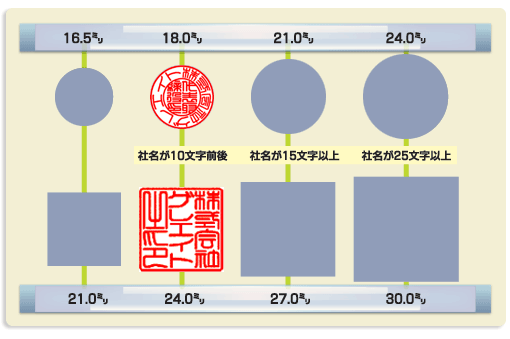
Engraved content
We engrave the company name or trade name on the square seal. In the case of square seals, the characters are often arranged in about three lines, so depending on the number of characters, we may add "in" or "noin" after the company name or trade name. We will make suggestions based on your preference and balance. Please also let us know your requests.
Generally, engraving is done vertically, but with the recent rise in the number of company names written in English, it is becoming more common to write horizontally. If the company name is only in Japanese, such as kanji, write it vertically, and if it uses alphabets, write it horizontally for easier reading and a better balance of the seal impression.

typeface
Once you have decided on the content to be engraved, choose the typeface that will become your design. We will introduce three typefaces in order of difficulty to read and difficulty to counterfeit.
Insoutai

The typeface that is the most difficult to read is Inso-tai.
It is a typeface designed based on seal calligraphy, and is mainly used for personal seals, and is a unique typeface for HANKO.
It has a design in which the lines of the letters spread out in all directions, and it has many points of contact with the outer frame of the engraving. It is a highly durable typeface that is difficult to counterfeit due to its curved lines. Because of its wide-opening design, it is sometimes said to be an auspicious typeface.
Seal typeface

The next most difficult typeface to read is seal script.
It features uniform line width on both sides. It has the beauty of geometric shapes and the dignity of ancient times. It is suitable for all seals, not just official seals. This typeface is especially popular for official seals and square seals.
Kointai

The rounded characters are characteristic of the Koin style. This style was created during the Nara period and is based on clerical script with added roundness.
This font is unique to Japan and is used on many pre-made personal seals. It is mainly used for personal seals.
Stamp material (HANKO material)
Square stamps and round stamps lose their effectiveness if the outer frame or characters of the stamp are missing, as verification becomes impossible. It is important to choose strong and durable materials that can be used for a long time.
ivory
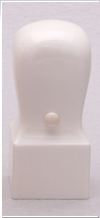
It is also called the "king of HANKO" and it is no exaggeration to say that it is the highest quality material for stamps. It is highly durable, heavy, and shiny, and it blends well with red ink, so you will grow to love it the more you use it. In addition, ivory stamps are highly valuable because the import is restricted by the Washington Convention.
To sell ivory, you need to register as a "Special International Species Business Operator."
Titanium
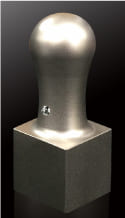
This material has become increasingly popular as a material for HANKO in recent years. Not only does its metallic appearance give it a luxurious and solid feel, but since it is a material that hardly wears out, it is more durable than other natural materials. Titanium is also used in medical equipment, and is a material that does not easily cause metal allergies.
In addition, despite its metallic appearance, it is easy to press, and the HANKO transfers beautifully, making it an easy-to-use stamp material.
dutch buffalo

This is a stamp material originating from South Africa, which is particularly hard and sticky among water buffalo, and is known as a superior stamp material.
The name does not originate from the Netherlands, but because it was exported around the world using the Netherlands as a collection point. In addition to stamping material, it is also used around the world as a material for clothing buttons and combs.
At ``Hanko Shop 21'', we sell Dutch water buffalo with few markings, and white Dutch water buffalo with no markings.
black buffalo
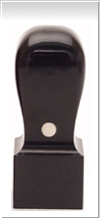
Similar to Dutch water buffalo, this stamp material is made from buffalo horn and is durable and can withstand long-term use, originating from Southeast Asia.
Usually, black buffalo is a stamp material that is dyed jet black, but natural black buffalo is not dyed and retains its natural color, so compared to black buffalo, it has a faint pattern on its surface. .
Mototsuge
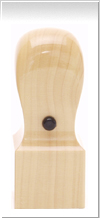
It has been used as a plant-based stamp material for a long time. It is a dense and hard wood, and the more you use it, the more it becomes glossy and beautiful.
Japanese psylliums are mainly produced in Japan and are classified into Shima pseudo and Satsuma pseudo, and currently Satsuma pseudo is the mainstream. Its distinctive feature is that it is yellowish and glossy compared to tsuge. Japanese psyllium is mainly imported from Southeast Asia and is also called Siamese psyllium. It is characterized by its beautiful wood grain.
Seal of sole proprietorship or freelancer
There are benefits to using Kakuin even if you are a sole proprietor or freelancer. Even individual business owners and freelancers often issue estimates and invoices to companies. At that time , just having the stamp stamped with a square seal creates a good impression and increases reliability. Although it is not necessary to create a square seal, it is a good idea to consider it as a thoughtful gesture to give the other party some peace of mind, as there are still many people who are concerned about doing business with individuals.
Types of square seals and their advantages and disadvantages
There are three types of square seals : HANKO, Shachihata, and electronic. We will introduce the advantages and disadvantages of each.
HANKO
HANKO are custom-made stamps engraved with the materials and lettering introduced in this article. Stamp materials such as ivory, buffalo, and titanium are hard and durable and do not easily deteriorate, giving them a luxurious feel.
To report and register as a registered seal or bank seal. There are many cases where HANKO are used to affix important documents, and there are also many documents where shachihata or electronic HANKO are not acceptable.
Penetration seal/shachihata
This stamp has ink built into its body. While it has the advantage of saving the trouble of attaching the stamp to the ink and allows continuous stamping, it has the disadvantage that the stamp surface is made of a material such as rubber, so it can deform or chip in a short period of time compared to a HANKO. .
Penetrative stamps are often referred to as "Shachihata", but this is the company name of Shachihata Co., Ltd., a manufacturer that mainly makes penetrative stamps.As the company's products have spread widely throughout the world, the name "Shachihata" is used to describe penetrative stamps made by Shachihata. Some people also call the penetrating stamp as a whole "shachihata."
electronic HANKO
A stamp that can be managed on a computer, and mainly refers to an image file format such as PNG, GIF, or JPG. It has the advantages of being able to stamp files on your computer, changing the size freely, and not needing to refill ink, but it cannot be used unless you convert it to an electronic file, and if you print it in black and white, the HANKO will be printed in black. There is also a disadvantage.
Recently, electronic contract services that allow documents to be created, managed, and even stamped have become popular.
How to use square stamps, company stamps, and round stamps
A company seal is a general term for a company's HANKO. The square seal is also called a "company seal," and since it is the company's official seal, even ordinary employees can affix it. However, the representative company seal, also known as the "maruin", is the official seal of the company, and is stamped by the company's representative on contracts that are important to the company. Such distinctions need to be thoroughly understood.
summary
I explained about the Kakuin (company seal). There are several types of HANKO used by companies, and they differ depending on their function and role. Please use the points on how to make a square seal introduced in this article when creating your own original company HANKO.
 日本語
日本語 English
English 简体中文
简体中文 繁體中文
繁體中文 한국어
한국어 ไทย
ไทย Tiếng Việt
Tiếng Việt Indonesia
Indonesia Français
Français Español
Español Português
Português
